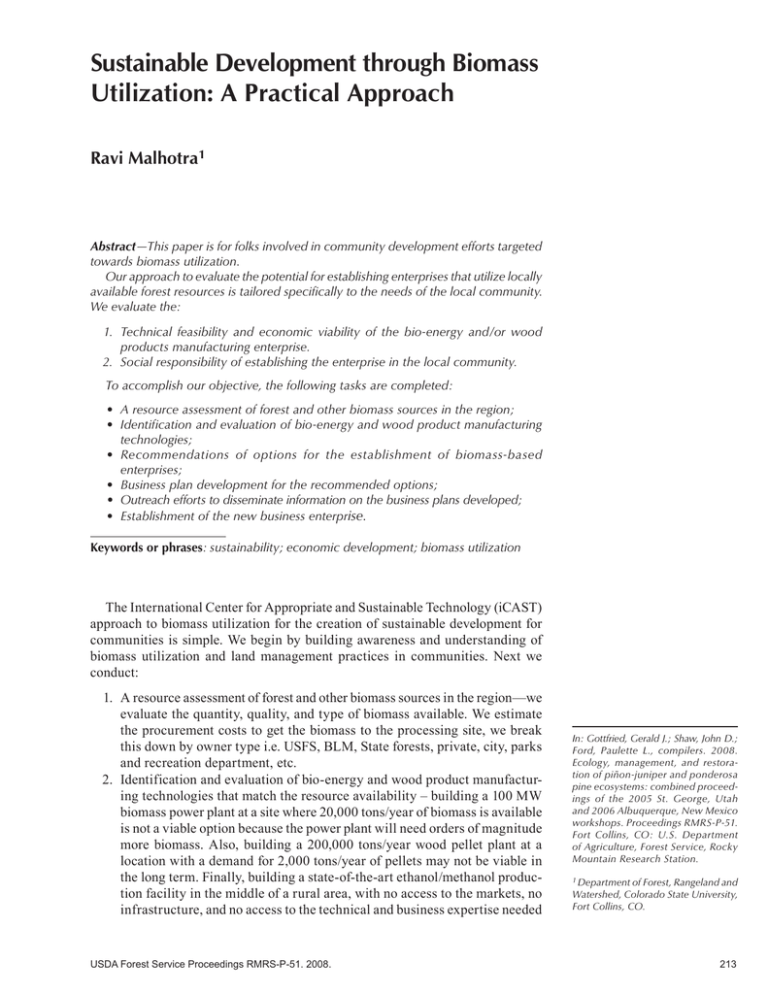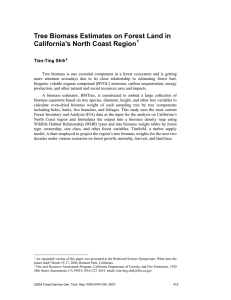Sustainable Development through Biomass Utilization: A Practical Approach Ravi Malhotra
advertisement

Sustainable Development through Biomass Utilization: A Practical Approach Ravi Malhotra1 Abstract—This paper is for folks involved in community development efforts targeted towards biomass utilization. Our approach to evaluate the potential for establishing enterprises that utilize locally available forest resources is tailored specifically to the needs of the local community. We evaluate the: 1. Technical feasibility and economic viability of the bio-energy and/or wood products manufacturing enterprise. 2. Social responsibility of establishing the enterprise in the local community. To accomplish our objective, the following tasks are completed: • A resource assessment of forest and other biomass sources in the region; • Identification and evaluation of bio-energy and wood product manufacturing technologies; • Recommendations of options for the establishment of biomass-based ­enterprises; • Business plan development for the recommended options; • Outreach efforts to disseminate information on the business plans developed; • Establishment of the new business enterprise. Keywords or phrases: sustainability; economic development; biomass utilization The International Center for Appropriate and Sustainable Technology (iCAST) approach to biomass utilization for the creation of sustainable development for communities is simple. We begin by building awareness and understanding of biomass utilization and land management practices in communities. Next we conduct: 1. A resource assessment of forest and other biomass sources in the region—we evaluate the quantity, quality, and type of biomass available. We estimate the procurement costs to get the biomass to the processing site, we break this down by owner type i.e. USFS, BLM, State forests, private, city, parks and recreation department, etc. 2. Identification and evaluation of bio-energy and wood product manufacturing technologies that match the resource availability – building a 100 MW biomass power plant at a site where 20,000 tons/year of biomass is available is not a viable option because the power plant will need orders of magnitude more biomass. Also, building a 200,000 tons/year wood pellet plant at a location with a demand for 2,000 tons/year of pellets may not be viable in the long term. Finally, building a state-of-the-art ethanol/methanol production facility in the middle of a rural area, with no access to the markets, no infrastructure, and no access to the technical and business expertise needed USDA Forest Service Proceedings RMRS-P-51. 2008. In: Gottfried, Gerald J.; Shaw, John D.; Ford, Paulette L., compilers. 2008. Ecology, management, and restoration of piñon-juniper and ponderosa pine ecosystems: combined proceedings of the 2005 St. George, Utah and 2006 ­Albuquerque, New Mexico workshops. Proceedings RMRS-P-51. Fort Collins, CO: U.S. Department of Agriculture, Forest Service, Rocky Mountain Research Station. 1 Department of Forest, Rangeland and Watershed, Colorado State University, Fort Collins, CO. 213 Malhotra Sustainable Development through Biomass Utilization A Practical Approach to operate and manage such as facility is not viable either. When evaluating biomass options we look at the technical feasibility i.e. is the technology reliable? And the level of automation i.e. is the technology cost effective and consistent? 3. Recommendations of options for the establishment of biomass-based ­e nterprises—Supply needs to match demand needs to match resource availability for a business to be truly sustainable. The iCAST approach to making recommendations involves using the decision matrix approach where the community is part of the decision making process and the final recommendation is based on their needs. When evaluating biomass options we look at the technical feasibility (i.e., is the technology reliable). And the level of automation (i.e., is the technology cost effective and consistent). We also look at economic viability by developing a business plan for the highest value-add products with a market analysis, financial plan and operations strategy. 4. Establishment of the new business enterprise—After developing a business plan for the recommended option, we conduct an outreach program to disseminate information on the business plans developed. The business plan includes a market analysis, financial plan, and operations strategy. The business plan is selected by prioritizing the options by impact on community. By creating a project plan and schedule for each option, we evaluate the ease of implementation. The optimal pilot project should be the one with the highest chance of success or lowest risk of failure so that it creates a success story for others. We support effective project implementation by identifying local entrepreneurs willing to work on the plan and assisting them in locating the funding and management team to execute on the business plan. We also provide real-life service learning opportunities to university students. Our approach involves developing a stakeholder-approved action plan that identifies innovative service learning opportunities for Colorado university students. Finally we disseminate the knowledge by conducting workshops in those communities in partnership with local stakeholders. Management Implications The beauty of our approach is in its simplicity. By matching local biomass supply to the business capacity and demands of the market, our approach ensures that the business is viable and sustainable for the long-term. Many times, the business capacity is driven by volume efficiencies and after a few years comes the realization that biomass supply is unable to meet demand so procurement costs rise or worse, the business is unable to run at capacity and is highly inefficient. The viability of the business was dependent on cheap biomass supply and so the business fails. Meeting local demand with local supply is a sustainable approach to not only business viability but also forest health, because there is no pressure for additional biomass resources from the utilization business. Acknowledgments The author wishes to acknowledge the insights provided by faculty in the ­Department of Forest, Rangeland and Watershed at Colorado State University, Fort Collins, Colorado. Special thanks to Dr. Kurt Mackes for this mentoring of all issues related to forestry and biomass. 214 USDA Forest Service Proceedings RMRS-P-51. 2008.






